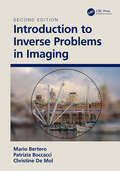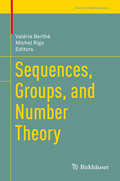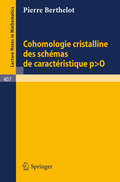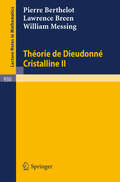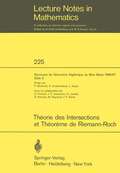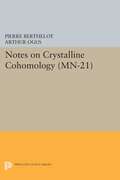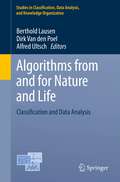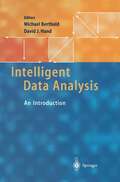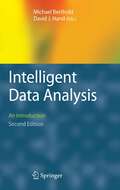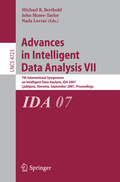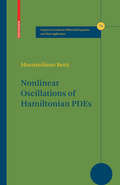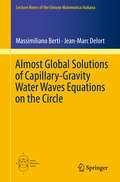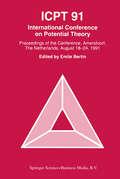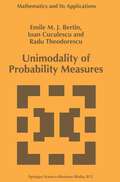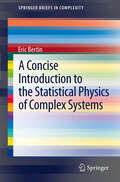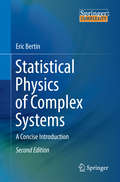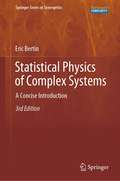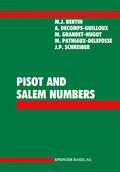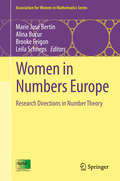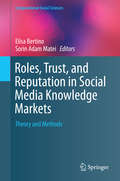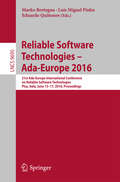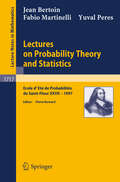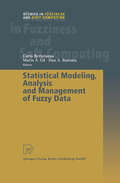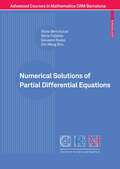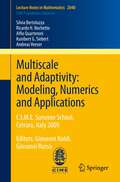- Table View
- List View
Introduction to Inverse Problems in Imaging
by M. Bertero P. Boccacci Christine De MolFully updated throughout and with several new chapters, this second edition of Introduction to Inverse Problems in Imaging guides advanced undergraduate and graduate students in physics, computer science, mathematics and engineering through the principles of linear inverse problems, in addition to methods of their approximate solution and their practical applications in imaging. This second edition contains new chapters on edge-preserving and sparsity-enforcing regularization in addition to maximum likelihood methods and Bayesian regularization for Poisson data. The level of mathematical treatment is kept as low as possible to make the book suitable for a wide range of students from different backgrounds, with readers needing just a rudimentary understanding of analysis, geometry, linear algebra, probability theory, and Fourier analysis. The authors concentrate on presenting easily implementable and fast solution algorithms, and this second edition is accompanied by numerical examples throughout. It will provide readers with the appropriate background needed for a clear understanding of the essence of inverse problems (ill-posedness and its cure) and, consequently, for an intelligent assessment of the rapidly growing literature on these problems. Key features: Provides an accessible introduction to the topic while keeping mathematics to a minimum Interdisciplinary topic with growing relevance and wide-ranging applications Accompanied by numerical examples throughout
Sequences, Groups, and Number Theory (Trends in Mathematics)
by Valérie Berthé Michel RigoThis collaborative book presents recent trends on the study of sequences, including combinatorics on words and symbolic dynamics, and new interdisciplinary links to group theory and number theory. Other chapters branch out from those areas into subfields of theoretical computer science, such as complexity theory and theory of automata. The book is built around four general themes: number theory and sequences, word combinatorics, normal numbers, and group theory. Those topics are rounded out by investigations into automatic and regular sequences, tilings and theory of computation, discrete dynamical systems, ergodic theory, numeration systems, automaton semigroups, and amenable groups. This volume is intended for use by graduate students or research mathematicians, as well as computer scientists who are working in automata theory and formal language theory. With its organization around unified themes, it would also be appropriate as a supplemental text for graduate level courses.
Cohomologie Cristalline des Schemas de Caracteristique p O (Lecture Notes in Mathematics #407)
by P. BerthelotTheorie de Dieudonne Cristalline II (Lecture Notes in Mathematics #930)
by P. Berthelot L. Breen W. MessingThéorie des Intersections et Théorème de Riemann-Roch: Séminaire de Géométrie Algébrique du Bois Marie 1966 /67 (SGA 6) (Lecture Notes in Mathematics #225)
by Pierre Berthelot D. Ferrand Alexander Grothendieck Jean-Pierre Jouanolou O. Jussila Luc Illusie S. Kleiman M. Raynaud Jean-Pierre SerreNotes on Crystalline Cohomology. (MN-21)
by Pierre Berthelot Arthur OgusWritten by Arthur Ogus on the basis of notes from Pierre Berthelot's seminar on crystalline cohomology at Princeton University in the spring of 1974, this book constitutes an informal introduction to a significant branch of algebraic geometry. Specifically, it provides the basic tools used in the study of crystalline cohomology of algebraic varieties in positive characteristic.Originally published in 1978.The Princeton Legacy Library uses the latest print-on-demand technology to again make available previously out-of-print books from the distinguished backlist of Princeton University Press. These editions preserve the original texts of these important books while presenting them in durable paperback and hardcover editions. The goal of the Princeton Legacy Library is to vastly increase access to the rich scholarly heritage found in the thousands of books published by Princeton University Press since its founding in 1905.
Algorithms from and for Nature and Life: Classification and Data Analysis (Studies in Classification, Data Analysis, and Knowledge Organization)
by Berthold Lausen, Dirk Van den Poel and Alfred UltschThis volume provides approaches and solutions to challenges occurring at the interface of research fields such as, e.g., data analysis, data mining and knowledge discovery, computer science, operations research, and statistics. In addition to theory-oriented contributions various application areas are included. Moreover, traditional classification research directions concerning network data, graphs, and social relationships as well as statistical musicology describe examples for current interest fields tackled by the authors. The book comprises a total of 55 selected papers presented at the Joint Conference of the German Classification Society (GfKl), the German Association for Pattern Recognition (DAGM), and the Symposium of the International Federation of Classification Societies (IFCS) in 2011.
Intelligent Data Analysis: An Introduction
by Michael Berthold David J. HandThis is a detailed introductory presentation of the key classes of intelligent data analysis (IDA) methods. The first part of the book discusses classical statistical issues. The following chapters concentrate on machine learning and artificial intelligence and provide introductions to the topics of rule induction methods, neural networks, fuzzy logic, and stochastic search methods. The book concludes with a higher level overview of the IDA process and illustrations of its application.
Intelligent Data Analysis: An Introduction
by Michael R. Berthold David J. HandThis second and revised edition contains a detailed introduction to the key classes of intelligent data analysis methods. The twelve coherently written chapters by leading experts provide complete coverage of the core issues. The first half of the book is devoted to the discussion of classical statistical issues. The following chapters concentrate on machine learning and artificial intelligence, rule induction methods, neural networks, fuzzy logic, and stochastic search methods. The book concludes with a chapter on visualization and an advanced overview of IDA processes.
Advances in Intelligent Data Analysis VII: 7th International Symposium on Intelligent Data Analysis, IDA 2007, Ljubljana, Slovenia, September 6-8, 2007, Proceedings (Lecture Notes in Computer Science #4723)
by Michael R. Berthold John Shawe-Taylor Nada Lavra 269This book constitutes the refereed proceedings of the 7th International Conference on Intelligent Data Analysis, IDA 2007, held in Ljubljana, Slovenia. The 33 revised papers were carefully reviewed and selected from almost 100 submissions. The book covers all current aspects of this interdisciplinary field, including statistics, machine learning, data mining, classification and pattern recognition, clustering, applications, modeling, and interactive dynamic data visualization.
Nonlinear Oscillations of Hamiltonian PDEs (Progress in Nonlinear Differential Equations and Their Applications #74)
by Massimiliano BertiMany partial differential equations (PDEs) that arise in physics can be viewed as infinite-dimensional Hamiltonian systems. This monograph presents recent existence results of nonlinear oscillations of Hamiltonian PDEs, particularly of periodic solutions for completely resonant nonlinear wave equations. The text serves as an introduction to research in this fascinating and rapidly growing field. Graduate students and researchers interested in variational techniques and nonlinear analysis applied to Hamiltonian PDEs will find inspiration in the book.
Almost Global Solutions of Capillary-Gravity Water Waves Equations on the Circle (Lecture Notes Of The Unione Matematica Italiana Ser. #24)
by Massimiliano Berti Jean-Marc DelortThe goal of this monograph is to prove that any solution of the Cauchy problem for the capillary-gravity water waves equations, in one space dimension, with periodic, even in space, small and smooth enough initial data, is almost globally defined in time on Sobolev spaces, provided the gravity-capillarity parameters are taken outside an exceptional subset of zero measure. In contrast to the many results known for these equations on the real line, with decaying Cauchy data, one cannot make use of dispersive properties of the linear flow. Instead, a normal forms-based procedure is used, eliminating those contributions to the Sobolev energy that are of lower degree of homogeneity in the solution. Since the water waves equations form a quasi-linear system, the usual normal forms approaches would face the well-known problem of losses of derivatives in the unbounded transformations. To overcome this, after a paralinearization of the capillary-gravity water waves equations, we perform several paradifferential reductions to obtain a diagonal system with constant coefficient symbols, up to smoothing remainders. Then we start with a normal form procedure where the small divisors are compensated by the previous paradifferential regularization. The reversible structure of the water waves equations, and the fact that we seek solutions even in space, guarantees a key cancellation which prevents the growth of the Sobolev norms of the solutions.
ICPT ’91: Proceedings from the International Conference on Potential Theory, Amersfoort, The Netherlands, August 18–24, 1991
by Emile M. J. BertinICPT91, the International Conference on Potential Theory, was held in Amersfoort, the Netherlands, from August 18--24, 1991. The volume consists of two parts, the first of which contains papers which also appear in the special issue of POTENTIAL ANALYSIS. The second part includes a collection of contributions edited and partly produced in Utrecht. Professor Monna wrote a preface reminiscing about his experiences with potential theory, mathematics and mathematicians during the last sixty years. The final pages contain a list of participants and a compact index.
Unimodality of Probability Measures (Mathematics and Its Applications #382)
by Emile M.J. Bertin I. Cuculescu Radu TheodorescuA Concise Introduction to the Statistical Physics of Complex Systems (SpringerBriefs in Complexity)
by Eric BertinThis concise primer (based on lectures given at summer schools on complex systems and on a masters degree course in complex systems modeling) will provide graduate students and newcomers to the field with the basic knowledge of the concepts and methods of statistical physics and its potential for application to interdisciplinary topics. Indeed, in recent years, statistical physics has begun to attract the interest of a broad community of researchers in the field of complex system sciences, ranging from biology to the social sciences, economics and computer science. More generally, a growing number of graduate students and researchers feel the need to learn some basic concepts and questions originating in other disciplines without necessarily having to master all of the corresponding technicalities and jargon. Generally speaking, the goals of statistical physics may be summarized as follows: on the one hand to study systems composed of a large number of interacting ‘entities’, and on the other to predict the macroscopic (or collective) behavior of the system considered from the microscopic laws ruling the dynamics of the individual ‘entities’. These two goals are, to some extent, also shared by what is nowadays called ‘complex systems science’ and for these reasons, systems studied in the framework of statistical physics may be considered as among the simplest examples of complex systems—allowing in addition a rather well developed mathematical treatment.
Statistical Physics of Complex Systems: A Concise Introduction (Springerbriefs In Complexity Ser.)
by Eric BertinThis course-tested primer provides graduate students and non-specialists with a basic understanding of the concepts and methods of statistical physics and demonstrates their wide range of applications to interdisciplinary topics in the field of complex system sciences, including selected aspects of theoretical modeling in biology and the social sciences. Generally speaking, the goals of statistical physics may be summarized as follows: on the one hand to study systems composed of a large number of interacting units, and on the other to predict the macroscopic, collective behavior of the system considered from the perspective of the microscopic laws governing the dynamics of the individual entities. These two goals are essentially also shared by what is now called 'complex systems science,' and as such, systems studied in the framework of statistical physics may be considered to be among the simplest examples of complex systems – while also offering a rather well developed mathematical treatment. The second edition has been significantly revised and expanded, featuring in particular three new chapters addressing non-conserved particles, evolutionary population dynamics, networks, properties of both individual and coupled simple dynamical systems, and convergence theorems, as well as short appendices that offer helpful hints on how to perform simple stochastic simulations in practice. Yet, the original spirit of the book – to remain accessible to a broad, non-specialized readership – has been kept throughout: the format is a set of concise, modular and self-contained topical chapters, avoiding technicalities and jargon as much as possible, and complemented by a wealth of worked-out examples, so as to make this work useful as a self-study text or as textbook for short courses. From the reviews of the first edition: “… a good introduction to basic concepts of statistical physics and complex systems for students and researchers with an interest in complex systems in other fields … .” Georg Hebermehl, Zentralblatt MATH, Vol. 1237, 2012 “… this short text remains very refreshing for the mathematician.” Dimitri Petritis, Mathematical Reviews, Issue 2012k
Statistical Physics of Complex Systems: A Concise Introduction (Springer Series in Synergetics)
by Eric BertinThis third edition of Statistical Physics of Complex Systems has been expanded to provide more examples of applications of concepts and methods from statistical physics to the modeling of complex systems. These include avalanche dynamics in materials, models of social agents like road traffic or wealth repartition, the real space aspects of biological evolution dynamics, propagation phenomena on complex networks, formal neural networks and their connection to constraint satisfaction problems.This course-tested textbook provides graduate students and non-specialists with a basic understanding of the concepts and methods of statistical physics and demonstrates their wide range of applications to interdisciplinary topics in the field of complex system sciences, including selected aspects of theoretical modeling in biology and the social sciences. It covers topics such as non-conserved particles, evolutionary population dynamics, networks, properties of both individual and coupled simple dynamical systems, and convergence theorems, as well as short appendices that offer helpful hints on how to perform simple stochastic simulations in practice. The original spirit of the book is to remain accessible to a broad, non-specialized readership. The format is a set of concise, modular, and self-contained topical chapters, avoiding technicalities and jargon as much as possible, and complemented by a wealth of worked-out examples, so as to make this work useful as a self-study text or as textbook for short courses.
Pisot and Salem Numbers
by Marie J. Bertin Annette Decomps-Guilloux Marthe Grandet-Hugot Martine Pathiaux-Delefosse Jean Schreiberthe attention of The publication of Charles Pisot's thesis in 1938 brought to the mathematical community those marvelous numbers now known as the Pisot numbers (or the Pisot-Vijayaraghavan numbers). Although these numbers had been discovered earlier by A. Thue and then by G. H. Hardy, it was Pisot's result in that paper of 1938 that provided the link to harmonic analysis, as discovered by Raphael Salem and described in a series of papers in the 1940s. In one of these papers, Salem introduced the related class of numbers, now universally known as the Salem numbers. These two sets of algebraic numbers are distinguished by some striking arith metic properties that account for their appearance in many diverse areas of mathematics: harmonic analysis, ergodic theory, dynamical systems and alge braic groups. Until now, the best known and most accessible introduction to these num bers has been the beautiful little monograph of Salem, Algebraic Numbers and Fourier Analysis, first published in 1963. Since the publication of Salem's book, however, there has been much progress in the study of these numbers. Pisot had long expressed the desire to publish an up-to-date account of this work, but his death in 1984 left this task unfulfilled.
Women in Numbers Europe: Research Directions in Number Theory (Association for Women in Mathematics Series #2)
by Marie José Bertin Alina Bucur Brooke Feigon Leila SchnepsCovering topics in graph theory, L-functions, p-adic geometry, Galois representations, elliptic fibrations, genus 3 curves and bad reduction, harmonic analysis, symplectic groups and mould combinatorics, this volume presents a collection of papers covering a wide swath of number theory emerging from the third iteration of the international Women in Numbers conference, “Women in Numbers - Europe” (WINE), held on October 14–18, 2013 at the CIRM-Luminy mathematical conference center in France. While containing contributions covering a wide range of cutting-edge topics in number theory, the volume emphasizes those concrete approaches that make it possible for graduate students and postdocs to begin work immediately on research problems even in highly complex subjects.
Roles, Trust, and Reputation in Social Media Knowledge Markets: Theory and Methods (Computational Social Sciences)
by Elisa Bertino Sorin Adam MateiKnowledge and expertise, especially of the kind that can shape public opinion, have been traditionally the domain of individuals holding degrees awarded by higher learning institutions or occupying formal positions in notable organizations. Expertise is validated by reputations established in an institutionalized marketplace of ideas with a limited number of “available seats” and a stringent process of selection and retention of names, ideas, topics and facts of interest. However, the social media revolution, which has enabled over two billion Internet users not only to consume, but also to produce information and knowledge, has created a secondary and very active informal marketplace of ideas and knowledge. Anchored by platforms like Wikipedia, YouTube, Facebook and Twitter, this informal marketplace has low barriers to entry and has become a gigantic and potentially questionable, knowledge resource for the public at large. Roles, Trust and Reputation in Social Media Knowledge Markets will discuss some of the emerging trends in defining, measuring and operationalizing reputation as a new and essential component of the knowledge that is generated and consumed online. The book will propose a future research agenda related to these issues. The ultimate goal of research agenda being to shape the next generation of theoretical and analytic strategies needed for understanding how knowledge markets are influenced by social interactions and reputations built around functional roles. The authors, including leading scholars and young innovators, will share with the readers some of the main lessons they have learned from their own work in these areas and will discuss the issues, topics and sub-areas that they find under-studied or that promise the greatest intellectual payoff in the future. The discussion will be placed in the context of social network analysis and “big data” research. Roles, Trust and Reputation in Social Media Knowledge Markets exposes issues that have not been satisfactorily dealt with in the current literature, as the research agenda in reputation and authorship is still emerging. In a broader sense, the volume aims to change the way in which knowledge generation in social media spaces is understood and utilized. The tools, theories and methodologies proposed by the contributors offer concrete avenues for developing the next generation of research strategies and applications that will help: tomorrow’s information consumers make smarter choices, developers to create new tools and researchers to launch new research programs.
Reliable Software Technologies – Ada-Europe 2016: 21st Ada-Europe International Conference on Reliable Software Technologies, Pisa, Italy, June 13-17, 2016, Proceedings (Lecture Notes in Computer Science #9695)
by Marko Bertogna Luis Miguel Pinho Eduardo QuiñonesThis book constitutes the refereed proceedings of the 21st Ada-Europe International Conference on Reliable Software Technologies, Ada-Europe 2016, held in Pisa, Italy, in June 2016. The revised 12 full papers presented together with one invited paper were carefully reviewed and selected from 28 submissions. They are organized in topical sections on concurrency and parallelism, testing and verification, program correctness and robustness, and real-time systems.
Lectures on Probability Theory and Statistics: Ecole d'Ete de Probabilites de Saint-Flour XXVII - 1997 (Lecture Notes in Mathematics #1717)
by J. Bertoin F. Martinelli Y. PeresStatistical Modeling, Analysis and Management of Fuzzy Data (Studies in Fuzziness and Soft Computing #87)
by Carlo Bertoluzza Maria A. Gil Dan A. RalescuThe contributions in this book state the complementary rather than competitive relationship between Probability and Fuzzy Set Theory and allow solutions to real life problems with suitable combinations of both theories.
Numerical Solutions of Partial Differential Equations (Advanced Courses in Mathematics - CRM Barcelona)
by Silvia Bertoluzza Silvia Falletta Giovanni Russo Chi-Wang ShuMultiscale and Adaptivity: C.I.M.E. Summer School, Cetraro, Italy 2009 (Lecture Notes in Mathematics #2040)
by Silvia Bertoluzza Ricardo H. Nochetto Alfio Quarteroni Kunibert G. Siebert Andreas VeeserThis book is a collection of lecture notes for the CIME course on "Multiscale and Adaptivity: Modeling, Numerics and Applications," held in Cetraro (Italy), in July 2009. Complex systems arise in several physical, chemical, and biological processes, in which length and time scales may span several orders of magnitude. Traditionally, scientists have focused on methods that are particularly applicable in only one regime, and knowledge of the system on one scale has been transferred to another scale only indirectly. Even with modern computer power, the complexity of such systems precludes their being treated directly with traditional tools, and new mathematical and computational instruments have had to be developed to tackle such problems. The outstanding and internationally renowned lecturers, coming from different areas of Applied Mathematics, have themselves contributed in an essential way to the development of the theory and techniques that constituted the subjects of the courses.
